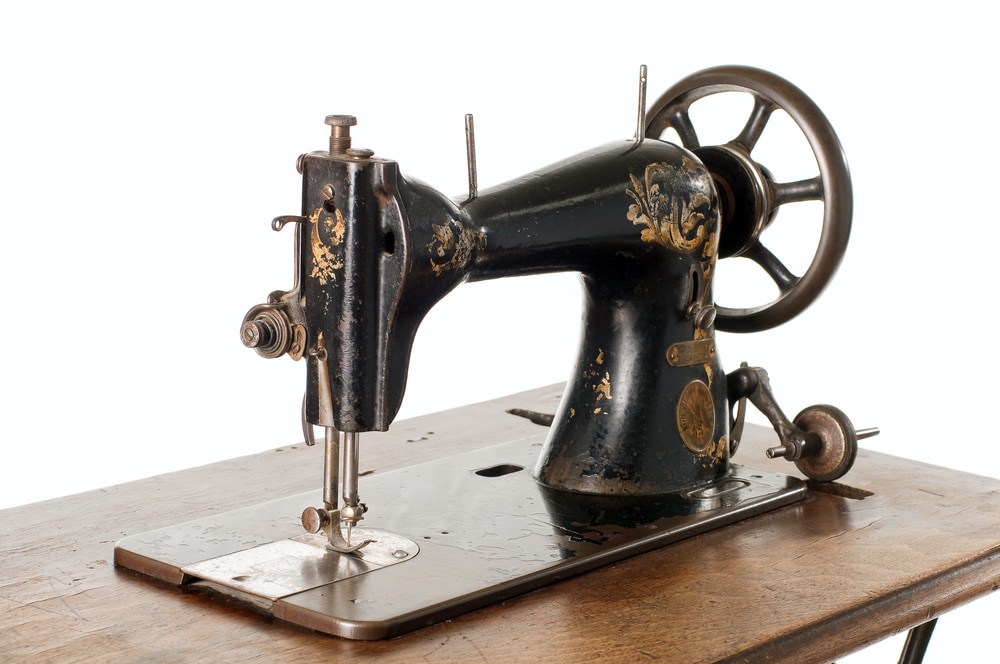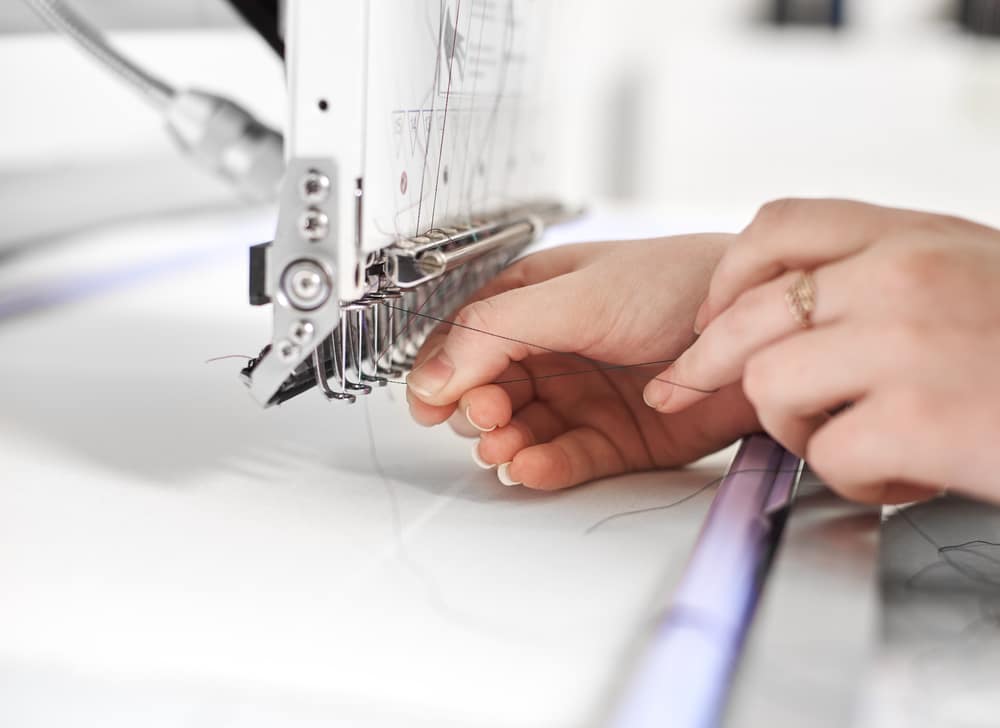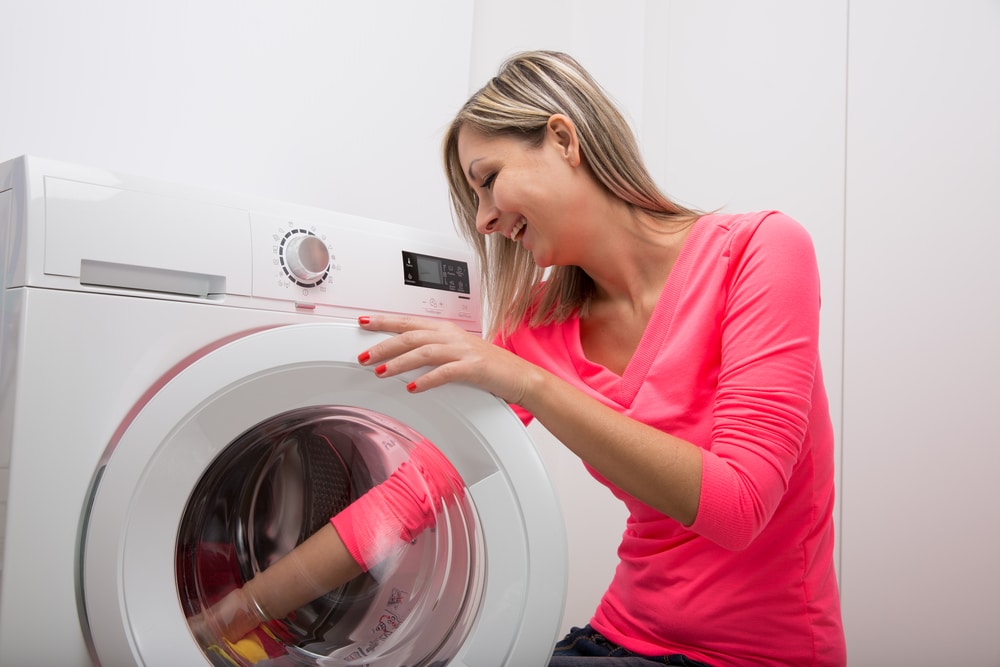Last Updated on
Sewing machines are used in commercial and home settings around the world. They are used for producing clothing, furniture, crafts, and more, but how did they become so popular? Where and when were sewing machines invented?
The invention and history of the sewing machine are not as straightforward as one might expect. It is filled with shocking events and even scandals.
To answer the question of who invented the first sewing machine, this article explores how sewing machines developed through time until they resembled the machines we know and love today. Keep reading to find out more about the inventors and eventual sewing machine producers who revolutionised the production of garments and textiles.
The History of the Sewing Machine
Hand Sewing: Sewing Machine Origins
Long before mechanical sewing machines existed, people were hand-sewing items around the world. It is generally accepted that the first evidence of sewing dates back to about 20,000 years ago. The first sewing tools were highly resourceful. Needles were made with animal horns and bones, and thread was made from animal sinew.
Later, during the 18th century, the industrial revolution created a demand for a more effective manner of sewing than the old-fashioned manual approach, and other inventions followed.
In 1755 the first patent related to a sewing machine was issued. Charles Weisenthal, a German immigrant reading in London, was issued a British patent for a sewing needle designed for use with a machine. However, no record of any such machine exists.
Who Was the Original Inventor of the Sewing Machine?
While the inventor of the sewing machine is somewhat contested, Thomas Saint is generally considered the inventor of the first machine used for sewing.
In 1790 a cabinet maker named Thomas Saint detailed and designed the very first sewing machine. His sewing machine invention was powered by a hand crank and used for sewing canvas and leather. The design included a feed mechanism, a vertical needle bar, and an overhanging arm.
Interestingly, there is no evidence showing that a prototype was ever built. However, in 1874 William Newton Wilson used the patent drawings submitted by Thomas Saint to build the machine to see if it worked. It did but only with several alterations.
Early Sewing Machine Design Attempts
After the Englishman Thomas Saint patented his design, several other sewing machine design attempts were made at the beginning of the 19th century before the first sewing machine that worked was made. These sewing machines were used with a needle that moved from side to side and used a winding handle for operation.
In France, Thomas Stone and James Henderson were awarded a patent for a machine that mimicked hand sewing in 1804. Unfortunately, it is unknown what happened to the invention.
Also, in 1804, a patent for an embroidery machine that used several needles was awarded to Scott John Duncan. Again, it is unknown what happened to the machine.
In Germany, Balthasar Krems invented the automatic machine for sewing caps in 1810. No patent was awarded to this sewing machine invention because it did not work.
A few years later, in 1814, Josef Madersperger, a Tailor from Austria, was issued a patent, but none of his various designs was successful. He was still working on developing the invention in 1839 and died with his work incomplete.
In 1818 a churchman from Vermont named John Adams Doge, along with his partner John Knowles, invented the first American sewing machine. While it was officially a working machine, it could not sew more than a few pieces of fabric before malfunctioning and requiring a reset, which required a considerable amount of time.
The First Effective Sewing Machine

Finally, in 1830 a French tailor by the name of Barthelemy Thimonnier invented the first sewing machine that was both effective and successful. Originally, this French tailor designed his first sewing machine for embroidery, but he soon realised its sewing potential and shifted his design ideas.
He was awarded a French patent for his functional machine, which used a hooked needle with a single thread to sew a chain stitch. The barbed needle was initially made mostly from wood. To use this machine, one must know how to thread properly.
Thimonnier’s successful patent led him to open the very first clothing manufacturing company that was machine-based. It contained 80 sewing machines and was commissioned by the French government to make uniforms for the French Army.
Unfortunately, other French tailors were violently displeased about the invention of this first sewing machine and its possibility of forming an angry mob and destroying the machines. They also burnt down the garment factory while Thimonnier was still inside. Fortunately, he did not die from the destruction.
Moving Foward in Time: More Failed Attempts
Four years after Thimnnier’s invention, in 1834, Walter Hunt designed and invented the first American sewing machine that worked. Walter Hunt’s sewing machine used two spools and executed a lockstitch but was only capable of short sewing seams that were straight. At first, Walter Hunt chose not to patent his invention because he believed it would eliminate jobs. It was finally patented in 1854.
Moving on, in 1842, an American named John Greenough made another working sewing machine. His machine utilised a needle that went entirely through the fabric. While a prototype was made, he couldn’t get anyone to manufacture his sewing machine, so it failed.
Soon after, in 1844, the English inventor John Fisher submitted a patent application for a more coherent sewing machine without as many disjointed parts as the earlier models contained. His sewing machine was designed to produce lace. Unfortunately, due to negligence at the American patent office, his application for the first machine of this kind was lost, and Fisher’s patent was never processed or awarded.
The First Practical Sewing Machine: Elias Howe
In 1845, a patent for a lockstitch machine was awarded to an American named Elias Howe. His creation somewhat resembled Fisher’s but with some improvements. His sewing machine utilised two sources of thread and had an eye-pointed needle. The needle went through the fabric to create a loop underneath. Then, a shuttle drew a second thread through the loop to create a lock stitch.
Elias Howe worked on his invention for eight years, but he had trouble effectively marketing his design in America. Even after arranging competitions against hand sewers to prove his machine’s speed and effectiveness, no one seemed to want to manufacture or buy his invention.
This caused him to travel to England, but his business venture there was unsuccessful as well. When Elias Howe finally returned to America, he discovered that other people had stolen parts of his design, his lockstitch mechanism in particular.
The Modern-Day Sewing Machine: Isaac Merritt Singer
In 1851 Isaac Merritt Singer created the first version of a sewing machine that resembles the ones we use today. Singer’s sewing machine had a foot pedal and a needle that moved up and down. It also had the first pivoted treadle.
To create his sewing machine, Isaac Singer combined elements from the earlier sewing machine inventions created by Hunt, Howe, and Thimonnier. He “borrowed” so much of their designs that he was sued for patent infringement by Howe.
The Singer lost the lawsuit and was forced to pay royalties and give Howe a share in the Singer company’s profits. Initially, he had to pay $25 for every machine sold, but the amount later dropped to $5 per machine.
Singer’s sewing machine rapidly grew in popularity and became a household brand name for seamstresses, tailors, and craft enthusiasts alike. Singer and Howe eventually combined their patents and worked together.
Their sewing machines have aided in the mass production of clothing and textiles ever since. Singer even pioneered the concept of instalment payments to make getting a sewing machine into homes easier and faster, even if you couldn’t afford to buy one all out.
Unlike their predecessors, Singer and Howe did not die penniless but instead were a great success. To this day, Singer is still the most popular manufacturer of sewing machines.
How Has the Invention of the Sewing Machine Impacted Our Society?
With an invention as revolutionary as the sewing machine, there is no surprise it changed society in several ways. Following are just a few of the many ways the invention of the sewing machine contributed to and changed the world as we know it.
- Sewing machines enabled mass production of textiles, causing the industry to grow exponentially.
- Thanks to these machines, people now get to enjoy better clothes that are high-quality.
- People began to have larger wardrobes as it was easier and faster to produce clothing. Clothing also became cheaper thanks to mass production.
- Sewing machines created many jobs in factories, particularly for women.
- They led to the growth of other industries like the cotton, metal, and furniture industries.
- In addition, sewing machines have become significant in producing toys, curtains, towels, and a whole range of products.
- Aside from the manufacturing industry, sewing machines also have become common in households. People use it for personal sewing, particularly for DIYs and crafts.
Sewing Machines and You
Sewing machines have come a long way since Thomas Saint’s hand-cranked device was designed for sewing leather and canvas. While sewing has always been somewhat of an art form, the industrial revolution and the invention of the sewing machine progressed what was truly possible and the speed at which sewing could be accomplished.
After reading through the wild history of the sewing machine filled with theft, deception, and even a riot, maybe the next time you break out your machine, you will take a moment to consider what went into bringing you such a useful and advanced device.
Let us know what you think in the comments below.
Emily is a woman of many talents. She has a B.A. in English and enjoys writing. Emily loves accessorising her home with quality products that not only serve a purpose but also enhance the overall convenience and tranquillity of her living space; there’s nothing like coming home to your own personal sanctuary after a long day! She loves anything that can make life easier or more comfortable—from dishware to furniture to lighting fixtures.



